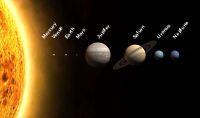
Photo from wikipedia
The distribution of professional observatories around the world is quite biased toward the Northern Hemisphere, and this tendency is even more pronounced when considering those dedicated only to the study… Click to show full abstract
The distribution of professional observatories around the world is quite biased toward the Northern Hemisphere, and this tendency is even more pronounced when considering those dedicated only to the study of small solar system bodies. In the Southern Hemisphere, the IMPACTON project deployed the Observatório Astronômico do Sertão de Itaparica (OASI), dedicated to the observation of minor bodies of the solar system with emphasis on Near-Earth Objects (NEOs). The observatory is located at the county of Itacuruba, in the Pernambuco State of Brazil, and operate a 1 m Cassegrain telescope. Here, we present a complete characterization of the OASI instruments and the sky conditions during the first eight years of operations. The limiting magnitudes are determined in the different available filters. The median seeing results to be 1 22, with a higher number of photometric nights from April to October. We also give an overview of the results obtained from the OASI observations and discuss them in the light of similar data from the literature. In particular, the rotational periods of 23 NEOs, and the spin directions and shapes of 9 NEOs, have been determined for the very first time using our observations. Analyzing rotational periods, sizes and taxonomic classification from the literature and OASI, we conclude that the fast rotating NEOs are predominantly S-type objects. However, rotational periods obtained at the OASI and with similar value from LCDB database allowed to identify the first fast rotator C-type NEO: asteroid 436724. With an estimated tensile strength as low as 0.5 KPa, this asteroid allows us to suggest that it defines the border between the Cand S-type fast rotators in the size versus period diagram. Although this hypothesis is based on a very small sample it is compatible with all presently available data. Only new observations, however, can prove if this hypothesis is correct. Unified Astronomy Thesaurus concepts: Telescopes (1689); Surveys (1671); NEOs (1092) Online material: color figures
Journal Title: Publications of the Astronomical Society of the Pacific
Year Published: 2020
Link to full text (if available)
Share on Social Media: Sign Up to like & get
recommendations!